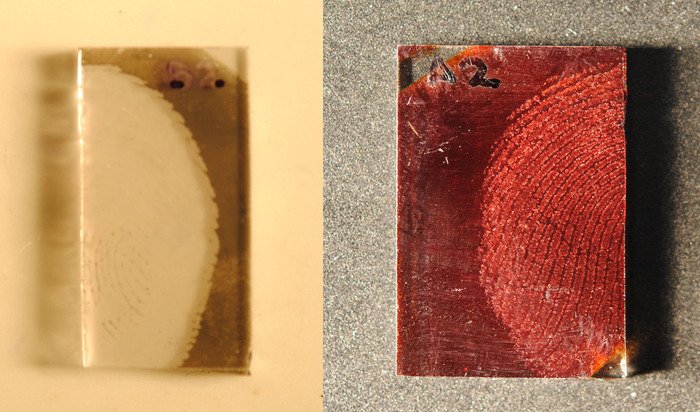The fingerprint on the left was prepared using an older development technique and does not show much ridge detail. The image on the right was prepared using new computer technique and shows a lot of ridge detail. Credit: Akhlesh Lakhtakia, Penn State
UNIVERSITY PARK, Pa., July 3 (UPI) -- Computer programs can give fingerprint grading, often subject to the subjectivity of the examiner, more consistency and objectivity, Penn State researchers say.
The quality of a fingerprint is often in the eye of the examiner, they said, which can mean identifications are problematic.
"People leave behind all kinds of fingerprints, and the job of a forensic examiner is then to look at a fingerprint and identify a person who could have left it," engineering science Professor Akhlesh Lakhtakia said. "Various scenarios can be envisioned where a fingerprint can be seriously altered. Once it is altered, it can conceivably lead the examiner to a false conclusion."
Fingerprints are subject to environmental weathering and smudging, and its subsequent condition affects how reliable a match can be between a collected print and prints on record, the researchers said, so knowing a fingerprint's dependability can minimize the chance of a wrongful or delayed conviction.
Lakhtakia's team created a process using computer programs to grade a fingerprint for the availability of ridge detail for subsequent identification, ensuring standardized evaluation to a degree finer than any human can accomplish.
"The quality of a fingerprint can be graded finer than on a zero, one, two, three scale," Lakhtakia said in a university release Wednesday. "Two-point-three percent is worse than 15 percent, but both could be graded as a zero by the naked eye. Humans can't grade finer than the zero to three scale. But computers can."
The ease and relative speed of this computer-based grading system may help to standardize fingerprint quality assessment in an inexpensive, efficient manner, the researchers said.















